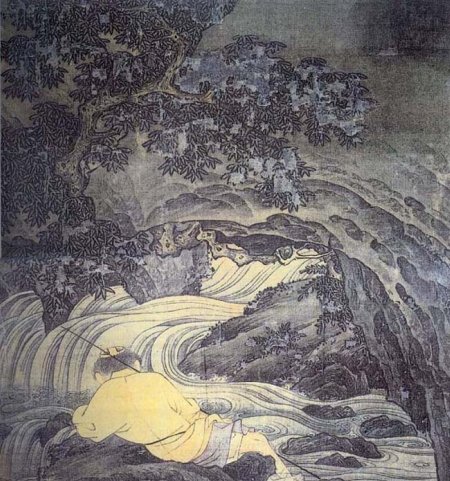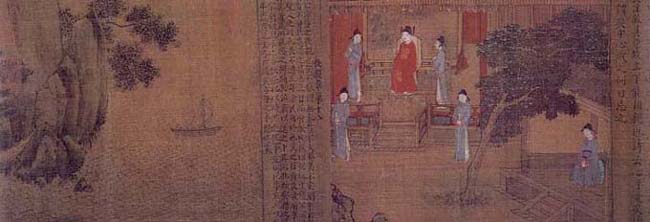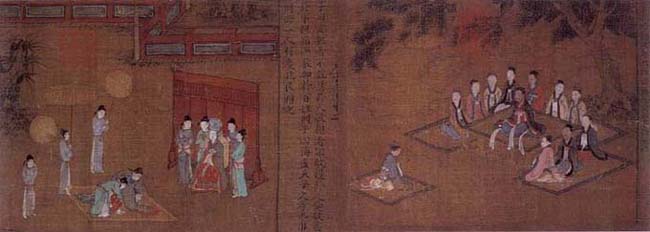960: The Cultural Emergence of the Northern Song
The founding emperor 太祖 established a revolutionary institutional framework by creating the Imperial Academy of Painting (翰林图画院) and the Calligraphy Academy. These institutions became the pillars of the artistic renaissance of the Northern Song (960-1127), fostering unprecedented production where court painting, scholarly creations, and folk art intensely interacted. This dynamic allowed the flourishing of innovative techniques such as 皴法 (mountain texturing) and the mastery of ink wash.

The Exploration
Painting on silk, 29.1 × 29.6 cm

Engraving of the Treatise of Young Girls
Painting on paper, variable dimensions


Engravings of the Treatise on Filial Piety
Moralizing illustrations of the Confucian tradition
The Undisputed Masters of Song Painting
范宽
A genius of monumental landscapes, his Travelers Among Streams and Mountains (溪山行旅图) illustrates the telluric power of the Zhongnan Mountains. His "rain-dot stroke" (雨点皴) creates overwhelming granite massifs where humans appear minuscule.
郭熙
Theorist of the "three-distance procedure" (perspective), his scrolls like Early Spring reveal mountains "rolled like clouds." Appointed by Emperor Shenzong as the "First Painter of the Empire."
李公麟
Nicknamed the "First Brush of the Song," he revolutionized figure painting with 白描 (pure line drawing). His works like The Five Horses combine anatomical precision and spiritual breath.
董源
Pioneer of southern landscapes, his "hemp fiber tracing" (披麻皴) influenced literati from the Yuan to the Qing. His scrolls like Views of the Xiao-Xiang River exalt river mists.
米芾
A brilliant calligrapher and creator of the "mist landscape" (米点山水), his ink-blot landscapes suggest more than they describe, foreshadowing abstract art.
徽宗
An aesthete emperor whose Coos of Doves combines ornithological precision and refined poetry. Founder of the Imperial Academy, he imposed naturalism as a canon.
Technical and Aesthetic Revolutions
The Apogee of Shan Shui Landscape
Song painters transcend representation to express 气韵 (cosmic breath). Guo Xi theorizes this in his treatise High Mountain Notes, advocating compositions where the viewer visually travels through the "three distances."
Social Painting and the Flourishing of Genres
Zhang Zeduan revolutionized narrative painting with Riverside Scene at Qingming Festival (清明上河图), precisely depicting the urban life of Kaifeng. Simultaneously, illustrated treatises like The Classic of Filial Piety spread Confucian ideology.
Decisive Material Innovations
- Improvement of wolf-hair brushes for vigorous strokes (Fan Kuan)
- Pine soot inks offering subtle nuances of 墨分五色 (five ink tones)
- Silks prepared with mineral glues allowing transparent glazes
Cultural Synthesis
Scholar-officials like Su Shi elevated painting to the art of 文人画 (literati painting), where poetry, calligraphy, and image merge on the scroll. Mi Fu embodied this synthesis by practicing the "three perfections" simultaneously.
Legacy and Posterity
The art of the Northern Song constitutes an unmatched pinnacle of Chinese culture. The Song masters inspired the Yuan schools (Huang Gongwang), Ming (the Four Wangs), and even modern artists like Zhang Daqian. Their works, preserved in the Taipei Palace and the Beijing Palace Museum, testify to a quest for harmony between nature and culture that remains at the heart of Asian aesthetics. Guo Xi's treatise summarizes this ideal: "A landscape is a place where one can travel with the mind, where one can rejoice with the eyes."
